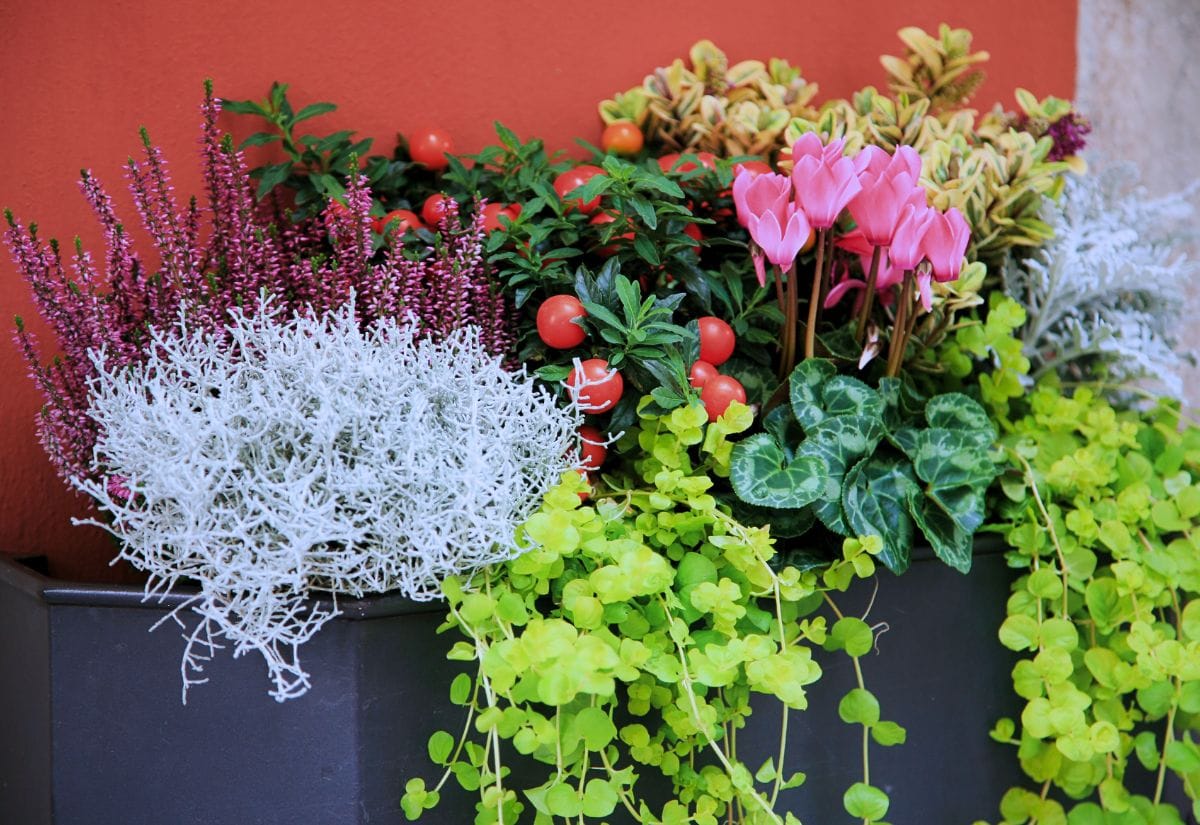
Fall is the “season of mellow wistfulness”, but also the time when we gardeners most need to fill in empty gaps in beds and borders with flowers… And bulbs usually hurry to catch the first light of the spring Sun to sparkle in it – but are they?
Not all! Luckily enough, there are quite a few bulbous perennial varieties that will bloom at the end of the season, before winter comes, often with warm autumnal shades of red, orange and yellow, but not only!
Even though they might not have the same star status as spring bulbs, fall-flowering bulbs are truly amazing. They start their blooming party just as summer begins to wind down, stepping in to jazz up any garden spots that might be looking a tad empty.
Sadly, these autumn-blooming bulbous plants often don’t get the attention they deserve. Most gardeners are busy basking in the summer sun or prepping for those spring blooms, and they miss the perfect window to plant these fall beauties. And trust me, it’s a real pity. These late-flowering bulbs aren’t just pretty, they’re super easy to handle too. So why not give them a shot?
Here’s the kicker, though – timing is everything. Knowing exactly when to plant your bulbs, tubers, corms, and even some types of rhizomes can keep your garden bursting with color for longer. Plus, it means you won’t risk losing your plants or having them flower too late in the season.
Once you’ve got these fall-flowering bulbs in the ground, some can be left to do their thing. They’ll even spread out and naturalize over time. But don’t forget, some of them need a bit of TLC and a cozy shelter when winter rolls around.
We’re going to get into the nitty-gritty of this, giving you all the info on when and how to plant these amazing fall-flowering bulbs. And trust me, they’re gonna make your autumn garden pop!
But before we dive into each of these bulb varieties and their unique quirks, let’s make sure we’ve nailed the planting basics.
When to Plant Bulbs for Fall Flowering
While most bulbous (tuberous, cormous or rhizomatous) perennials that blossom in fall need to go into the soil in spring, there are many exceptions and two things you need to keep in mind.
And now we can get straight into the most beautiful bulbs for fall blossoms, and we can start with a very generous variety indeed!
15 Bulbous Perennials for Fall Blooms To plant In your Garden
So, bright and colorful, with late and long lasting floral displays, here are 15 flowing bulbs that will blossom in fall.
1: Guernsey Lily (Nerine sarniensis)
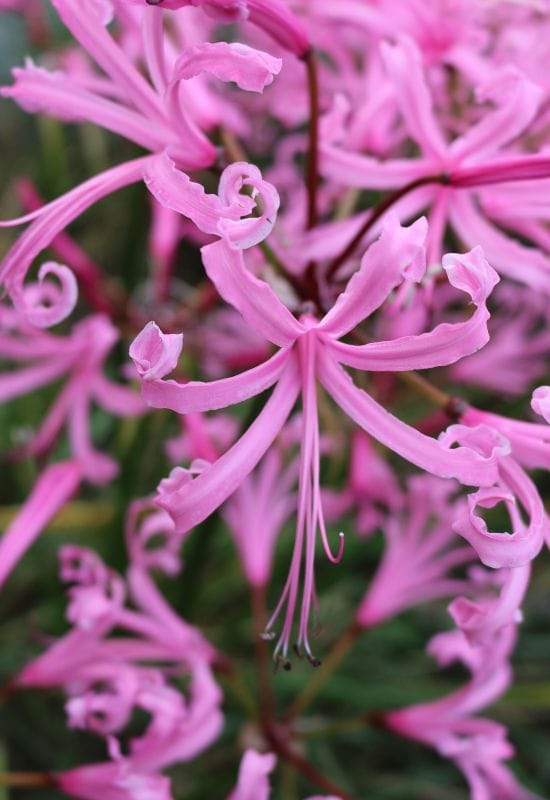
Guernsey lily is a classic fall flowering bulbous perennial. Its large umbels of blooms shaped like trumpets with 6 long petals that open at the mouth like a star on fire, they will open as early as late summer, and continue well into the autumnal season.
The exotic looking Nerine sarniensisspecies hails from South Africa, and it has blooms of the most vivid scarlet with waved edges, but varieties in other shades exist as well. So, for example, Nerine bowdeniiis bright deep pink, while its cultivar ‘Albivetta’ pales to faint and pastel rose.
Covered in a glossy sheen, they are also called diamond lilies for a reason… Mid green a and strap shaped leaves form a lovely tuft under the long stems, with their lush presence.
To allow it to bloom by the end of season, you need to plant it in early spring. But if you live in cold climates, wait a bit longer, till you are sure that there won’t be any frost days.
A heat loving bulb, Guernsey lily is very exotic looking and ideal for tropical and Mediterranean gardens. It is not cold hardy, but you can simply uproot the bulbs and store them in a cool, dry, ventilated and dark place over the winter months once the foliage has died down.
2: Montbertia (Crocosmia spp)
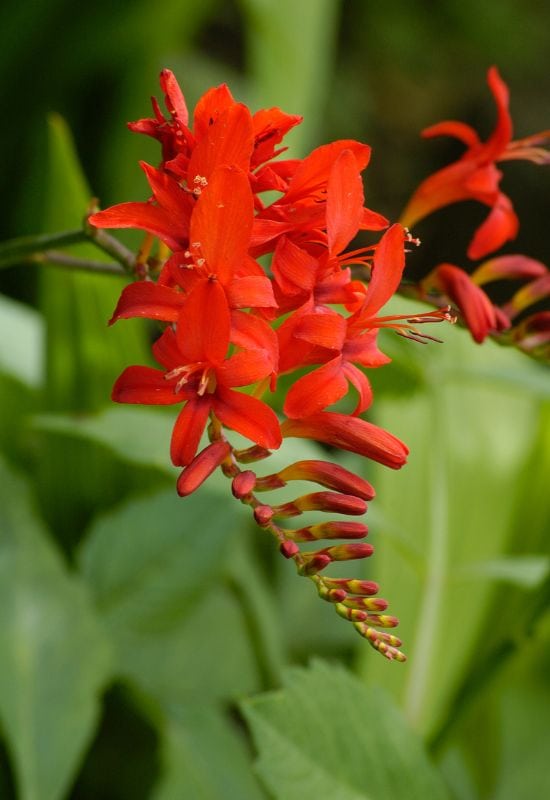
Montbertia pick up the colors of the autumnal Sun to reflect them in its bright blooms all the way from mid summer into fall. The arching branches fill with showy, start shaped blossoms that open in succession, keeping your garden vibrant for a long time indeed!
The color range goes from the mustard to butter yellow of ‘Buttercup’ (Crocosmiaxcrocosmiiflora ‘Buttercup’) to the luminous golden of ‘Columbus’ (Crocosmia x crocosmiiflora ‘Columbus’) the the fiery scarlet of ‘Lucifer’ (Crocosmia ‘Lucifer’),
maybe the most eye catching of all cultivars, with wine purple stems, and winner of the Award of Garden Merit by the Royal Horticultural Society. But the bright orange and red Crocosmia ‘Bright Eyes’ and the coral pink Crocosmia ‘Limpopo’ are with considering too.
Long, sword shaped and mid green leaves rise from the base to just about the height of this exotic floral show.
Excellent for a tropical and warm touch in fall borders, you will need to plant the corms soon after any danger of frosty days is over, from early to mid spring, quite deep, about 6 to 8 inches (15 to 20 cm), or its tall height will make it topple. In cold climates, uproot them and winterize them, though it is fairly cold hardy.
3: Autumn Crocus (Colchicum spp.)
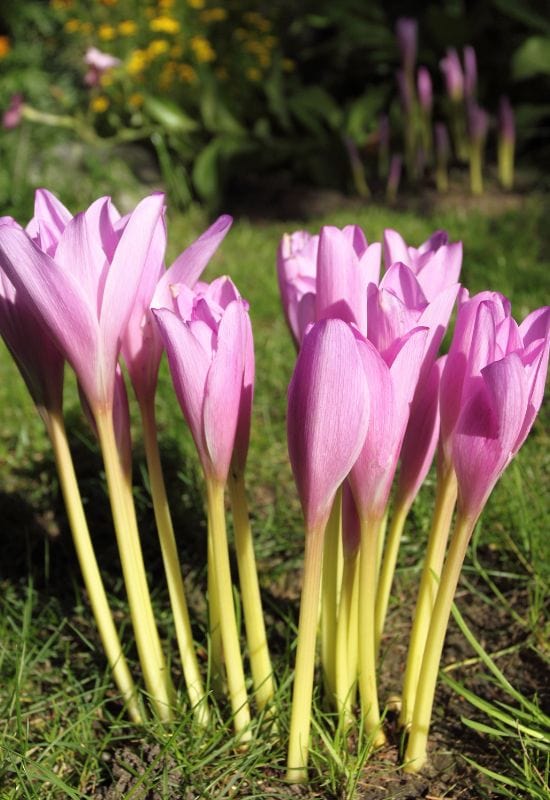
Autumn crocus looks like its springtime namesake, but of course, it will blossom in fall. There are quite a few species, and the biggest is Colchicum giganteum, which reaches 12 inches tall (30 cm), and that’s the actual flower… So,
a bit bigger than its more famous lookalike. Coming straight from the pretty large bulb in the soil, similar to those of tulips, the cup shaped blossoms are typically lavender pink, but there are also white ones like Colchicum speciosum ‘Album’.
But when this perennial is showing us its floral beauty, it hides the leaves. Broad, deep green, semi glossy and long, they will appear in spring and, and then die back by summer, when this plant “takes a break” and it goes dormant before it blooms.
And it is exactly at this time that you can plant it, in late spring or early to mid summer. Autumn crocus is yet another fall flowering bulbous perennial that will naturalize easily; it likes fresh environments, like under trees, and you can get up to 10 flowers for each bulb!
4: Peruvian Lily (Alstromeria spp.)
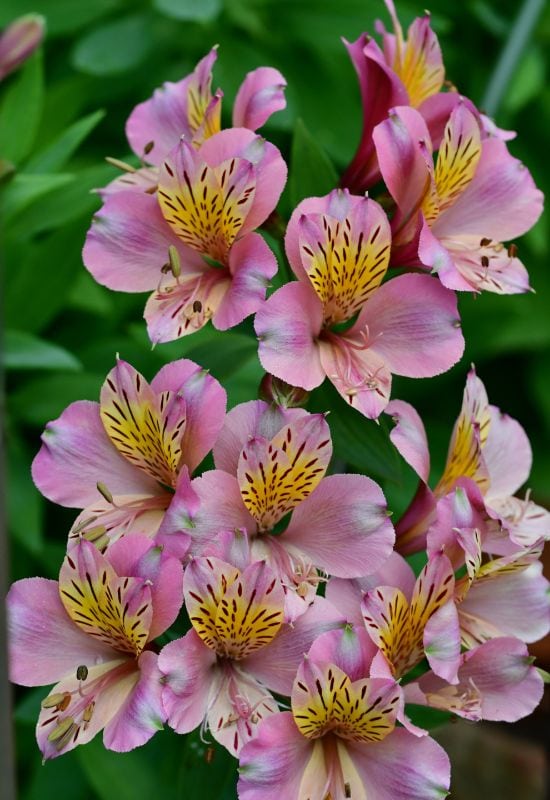
A variety of tuberous perennial that really offers you a wonderful range of warm colors for an end of season display is Peruvian lily. It will start in summer, but its exotic blossoms will keep coming in great numbers all the way into fall.
Famous for the decorative streaks in darker shades it displays on the upper and lower petals, it really has a lovely palette. Pink with a bright yellow and red stripes are what you find on ‘Princess Elaine’, for example, while ‘Princess Fabiana’ has cream and rose.
‘Princess Matilde’ has coral and saffron with brown dashes, while ‘Princess Diana’ a dash of pink at the center, bright orange red at the tips, dark yellow with purple marks in the middle.
An unusual cultivar is ‘Antarctica’, snow white with plum flecks. The semi glossy, mid green foliage has long leaves that grow all the way up to the stem.
When it comes to planting, you do have a long period with Peruvian lily; it is best in spring or even early summer, but you can even do it in fall, but it will blossom the year after if you do, and only in warm regions. In colder ones, you need to uproot the tubers and shelter them over winter.
5: Winter Daffodil (Sternbergia lutea)
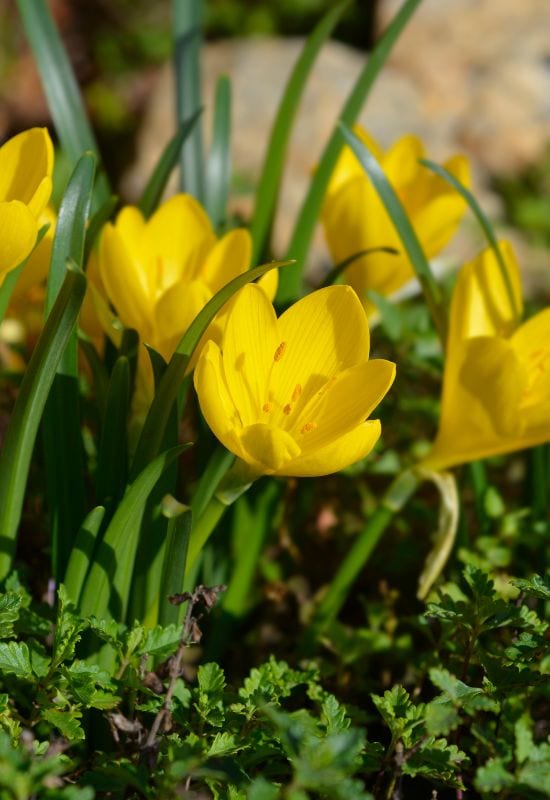
Yes, it is called winter daffodil, but this bulbous perennial actually blossoms in fall. And it does not look like a daffodil, or Narcissus, at all!
In fact the cup shaped and upward looking bright golden yellow flowers look like little tulips, or big crocuses, and they are about 1.5 inches across. Coming in stems that reach about 6 inches tall (15 cm) they are both cheerful and sweet looming.
Perfect for rock gardens but also containers and flower beds, this winner of the prestigious Award of Garden Merit by the Royal Horticultural Society derives its name from the fact that the tufts of deep green, strap like leaves that grow at the base of the floral display can persist on during the cold season, if the weather is mild.
Yet another variety of flowering bulbs for fall that naturalizes very easily, you can plant it in late summer, or even in September about 4 inch deep into the soil (10 cm).
6: Natal Lily (Crinum moorei)
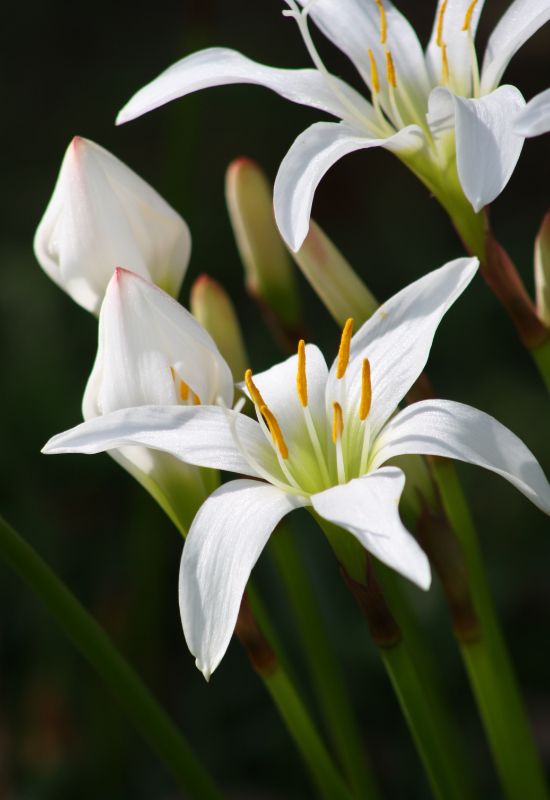
Natal lily really looks like its relatives of the Lilium genus, though its bulbs look different; they are similar to those of hyacinths, fairly large and you will need to plant in mid or late spring about 6 to 10 inches deep into the ground (15 to 20 cm).
Wait a few weeks and you will see a lovely rosette of fleshy, bright green and wavy leaves rise out of the soil. A long stem will arise from the middle, which will carry between five and ten blossoms.
Large and star shaped, with elegant arching pistils and dark brown anthers, they are of the purest snow shite tonality you can ever see! Each flower head is about 4 inches long (10 cm), quite showy and a very candid touch to add to your borders or beds for a luminous end of season display.
The actual flowering season of Natal lily will start at the end of summer and it will continue well into the months of fall. Native of South Africa, it retains an exotic beauty but it is low maintenance. In USDA zones 6 and below, you will have to uproot the bulbs and keep them safe over winter.
7: Pineapple Lily (Eucomiscomosa)
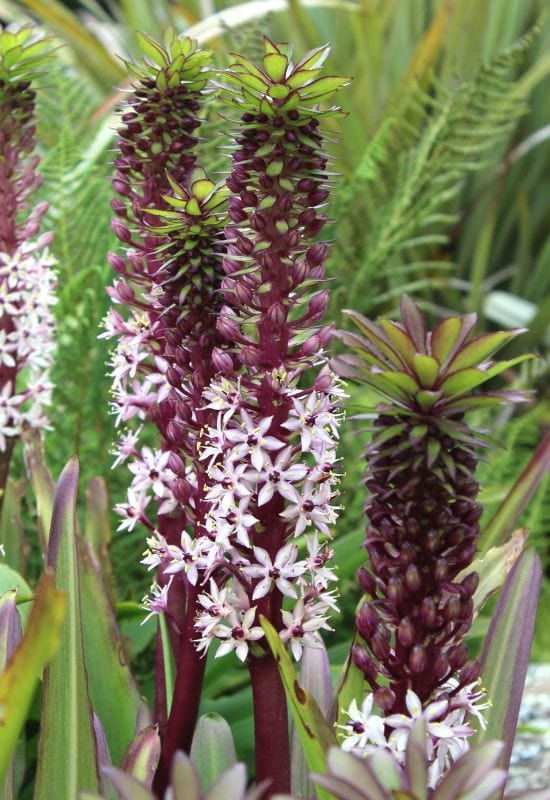
Pineapple lily, a.k.a. king’s flower is an original looking bulbous perennial for autumnal beauty and blooms. The inflorescences grow on upright stems with many star shaped flowers packed together, and they will start in late summer and continue through the months of fall.
There are a few well known and readily available cultivars, like the cream white ‘Glow Sticks’ and the rose pink ‘Vandermerwei’, where the blossoms open from equally attractive deep purple buds. Others will offer you lilac and white shades as well.
The name comes from its really impressive foliage. The fleshy long, broad and pointed leaves with wavy margins form exotic looking rosettes, that remind us of the tuft in top of the famous and refreshing fruit we all love.
And their glossy surface can be bright or dark green, but as the season progresses, it takes on lovely shades of copper, purple, and even latte!
You should plant the large bulbs about 6 inches deep in the soil (15 cm) in spring, best if mid or late, unless you live in a warm region, as you must absolutely avoid that they endure frost and severe temperatures.
8: Belladonna Lily (Amaryllis belladonna)
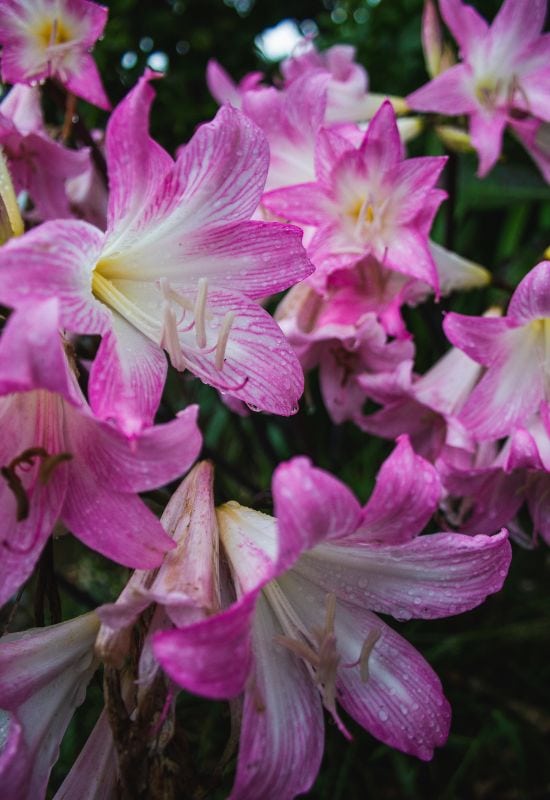
Also called naked lady, belladonna lily, well known with its scientific name, is one of the best outdoor varieties of amaryllis. The bigand fragrant flowers with six petals will open in late summer and they will continue into fall, and they are about 4 or 5 inches across (10 to 12.5 cm).
They come atop thick upright stems, in clusters of 5 to 10. In the very center, there’s a golden yellow patch, while most of the bloom is in bright shades of pink that strengthen and fade on the blossom itself. However, the ‘Alba’ variety is snow white.
Long and elegant pistils and a stamen arch, in the same color range. This exotic bulbous perennial from South Africa will actually naturalize very easily in warm regions; I have seen it grow spontaneous in the Mediterranean area.
Winner of the Award of Garden Merit by the Royal Horticultural Society, it also produces long and thin, tongue like fleshy green leaves, but after the floral display, lasting through winter to die back in spring.
The best time to plant its large bulbs (about 10 inches in circumference, or 25 cm) is I. Summer, when it is dormant, but you can do it earlier, in fact, starting in April, even eariler in warm countries. Remember that you need to leave the neck out of the soil.
9: Perfumed Spider Lily (Hymenocallis latifolia, or Pancratium latifolium)
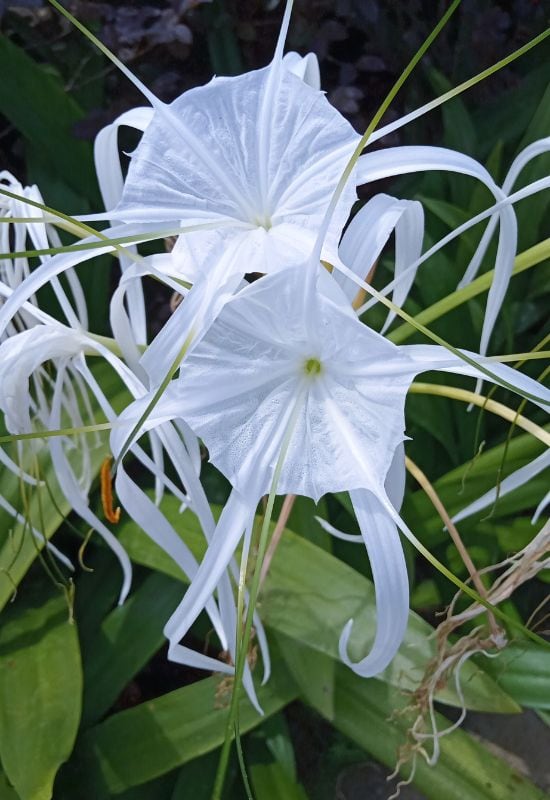
Possibly closely related to Pancratium, that beach flower you may have seen in holiday in the Mediterranean (what a spectacle!),
perfumed spider lily is actually a soft bulbous perennial from Florida, Texas and the West Indies, with a much longer flowering season, that lasts from early spring, through summer and fall as well!
What is more, it grows in different soil types (not just sand) but it retains some of its amazing appearance. Fully white, the fragrant flowers have a central cup and six amazingly long, thin and arching petals, that make it look like a spider, in fact.
They are about 5 inches across (12.5 cm) and the odd thing is that the pistils grow from the margin of the cup itself! Coming in clusters above the leathery and evergreen foliage, you will enjoy the bright green, strap shaped leaves in large clumps as well all year round!
The drawback of this exotic looking and long blooming bulbous perennial is that it is not at all cold hardy, and you can plant it in late winter or early spring. Place the bulbs about 4 inches deep into the soil. You can also propagate it easily by seed.
10: Abyssinian Sword Lily (Gladiolus callianthusmurielae)
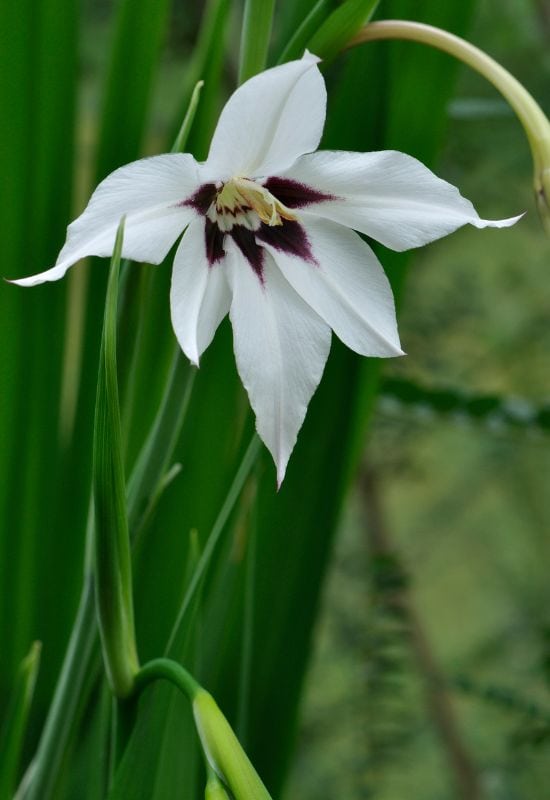
Native of Ethiopia and Madagascar, this usual species of Gladiolus, Abyssinian sword lily, or peacock orchid, blooms later than its sisters, starting in late summer and continuing with repeated blooms into the months of fall.
The nodding blooms are about 2 inches across (5.0 cm) and they have a very unusual shape, with pointed and almost diamond shaped petals (tepals) of different sizes, with two large “wings” on the side.
You will get about 10 on each stem, and the whiteness of the bloomscontrasts with the deep plum purple patch that it displays in the center. Elegant and good for a virtual accent in flower beds and borders, it will also offer you its long, blade like and medium green leaves through the same season. It is also a winner of the Award of Garden Merit by the Royal Horticultural Society.
Wait till the last day of frost is safely over before planting the corms in spring; group planting is highly advisable, to a depth of about 4 inches deep (10 cm).
In climates with low temperatures in winter, USDA zones 6 and below, you will need to uproot them at the end of fall, when the leaves die back, and shelter them during the cold season.
11: Cilician Cyclamen (Cyclamencilicium)
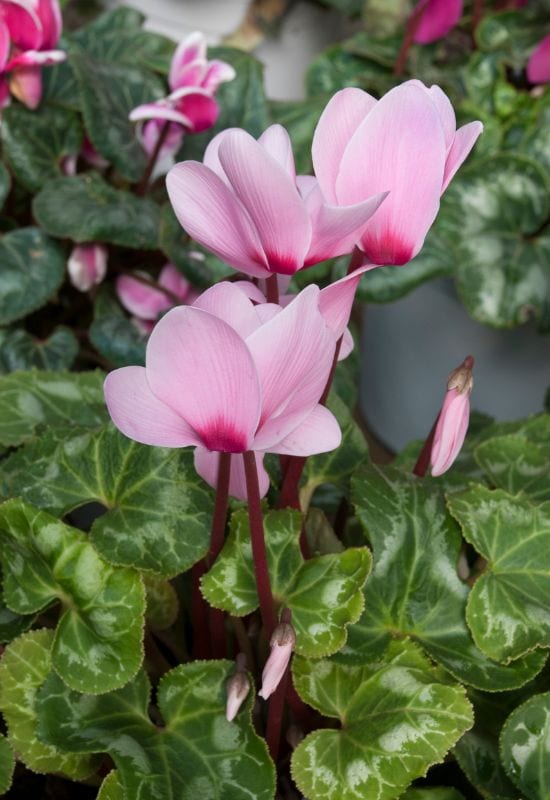
A cyclamen variety that blooms all through fall, is cilician cyclamen, also known as sowbread or Turkish hardy cyclamen. Its delicate looking flowers nod beautifully on short and curving purple stems,
with reflexed petals that arch outwards, unlike other varieties in this genus, giving you the impression of butterflies flapping their wings low down almost at ground level.
They are lilac pink in color, pale but with bright blushes, darker at the mouth, and they also have very regular lines that go along them, providing a refined texture.
And these blossoms are about 1 to 1.3 inches across (2.5 to 3.0 cm), not bad for Cyclamen!They also have a delicious though faint scent of sweet honey! The leaves are heart shaped, very glossy and deep forest to hunter green,
with silver speckles on them and they will stay on through the winter season if it is not too cold. This winner of the Award of Garden Merit will also naturalize willingly in USDA zones 5 to 9.
Oddly enough, the best time to plant the tubers is in very early fall, just before it blossoms, because it does it as soon as it wakes up from dormancy, late summer is also possible. The depth should be about 2 inches (5.0 cm).
12: Dahlia (Dahlia spp.)
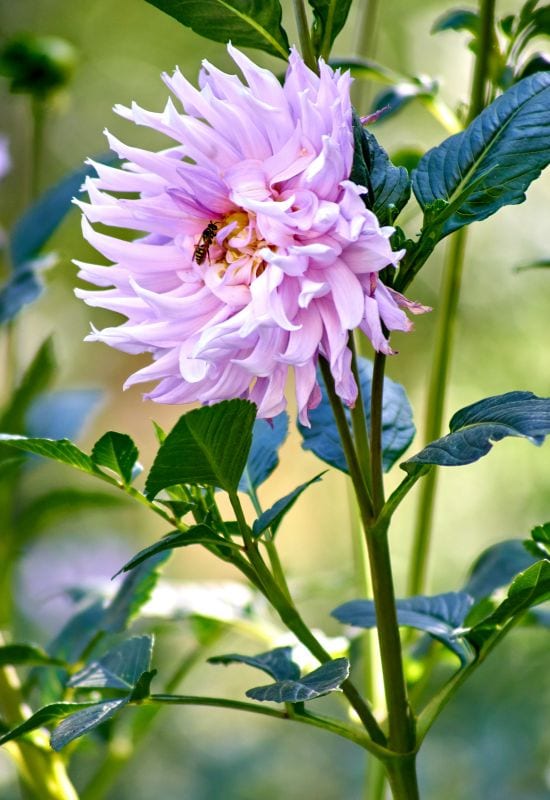
Dahlias grow fast and give us their eye catching blossoms from tubers in the soil, which you can plant as soon as it is warm, after the first frost in spring. And by mid summer, they will be in full bloom, and they will continue all the way to do so till mid or even late fall.
In fact, depending on the season, they can last for 5 months! And you don’t need me to tell you that some flowers of this genus reach impressive sizes, up to 14 inches across (35 cm)!
With single, double, cactus, anemone, collarette and pompon varieties, the choice of shapes is huge! Then again, you have also a palette of white and warm colors, usually bright and vibrant, that’s perfect tor a late season blush.
Yellows, pinks, oranges, reds and purples are all available, with some striking bicolor cultivars like ‘Ferncliff Illusion’ (white and magenta) or ‘Gallery Art Deco’ (coral and crimson) as well! The lush foliage provides an excellent setting for this breathtaking floral display.
Dahlias are not cold hardy, so you will need to plant the tubers in spring and then save them from frost at the end of the season, as usual,
uprooting them once they start wilting (and always before it freezes), and store them safely. In cold climates, don’t worry if the plant has not died back yet; better safe than sorry!
13: Waterlily (Nymphaea spp.)
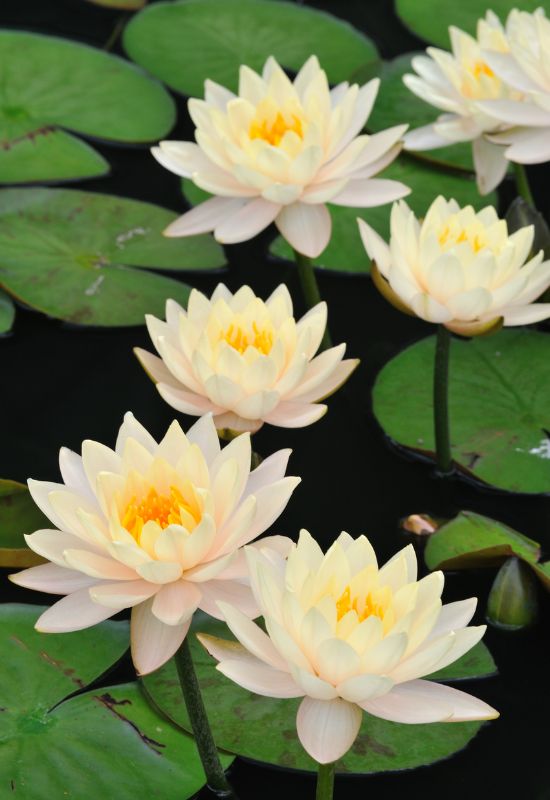
Watelilies have an amazingly long blooming season, that can last from late spring to late fall! One such variety is the awe inspiring ‘Black Princess’, with waxy dark ruby petals, or the rose pink ‘Colorado’…
Most will venture into the autumnal months, and if you have a pond… They are actually tuberous or rhizomatous perennials, which makes them very easy to grow and propagate.
The best way is to wait after the risk of frost is over, place the tubers in clay soil balls and push them just under the surface of the soil underwater. This way, you will anchor them to the bed till they grip to it with their roots.
Very soon, it will send its beautiful round leaves to float on the surface of the water, and then the first buds will start cropping up between them. When they open, it is like a mystical spectacle, till they reveal their iconic blooms, in all shades except green, and that can reach 10 inches across!
With dwarf and giant varieties, there is a waterlily in any color for the size of your pond… You can pick any size, from those that need only 10 inches of water (25 cm) to the colossal Victoria boliviana, with leaves that reach 10.5 feet across (3.15 meters)!
14: Toad Lily (Tricyrtisspp.)
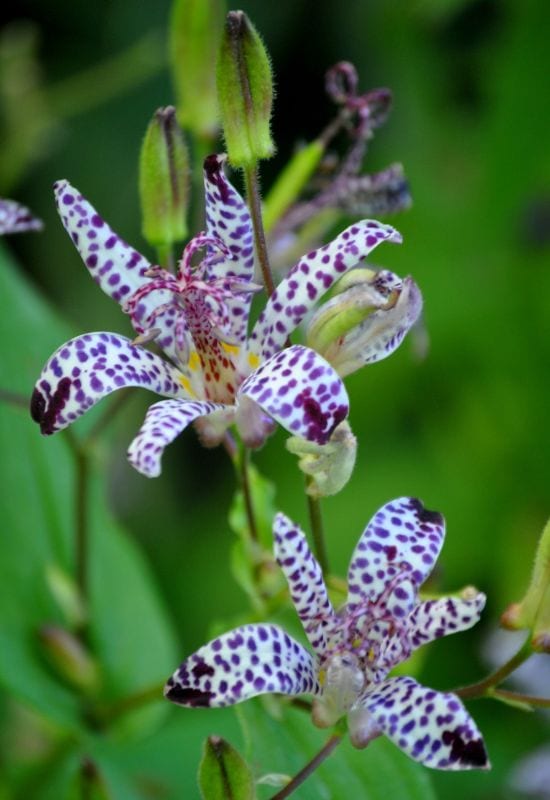
Toad lilies are some of the weirdest perennials you can have in your garden! So called because they are spotted, they also have an unusual shape with large and extended reproductive organs in the middle of the flowers that look like jester hats, and many see a resemblance with orchids.
In reality, they belong to the lily family, Liliaceae… And they grow from underground rhizomes, with the main species being Tricyrtishirta, T.formosana, T. latifolia, with many cultivars as well.
Their blooms keeps coming from late summer to late fall, with clusters of maculated blooms in shades of red, orange, pink, purple, blue and even yellow.ypu can plant them as soon as there is no longer any risk of frost, and you will enjoy their long lasting floral displays on long stems with fleshy, pointed mid green leaves for an exotic touch in your beds and borders.
Toad lilies are native of Asia and the Philippines, and they retain a very exotic look, but they are actually quite cold hardy, used to growing even on the Himalayas, so you can leave the rhizomes in the ground if you live in USDA zones 5 or above, once they have established, but divide them every two or three years.
15: Tuberous Begonias (Begonia spp.)
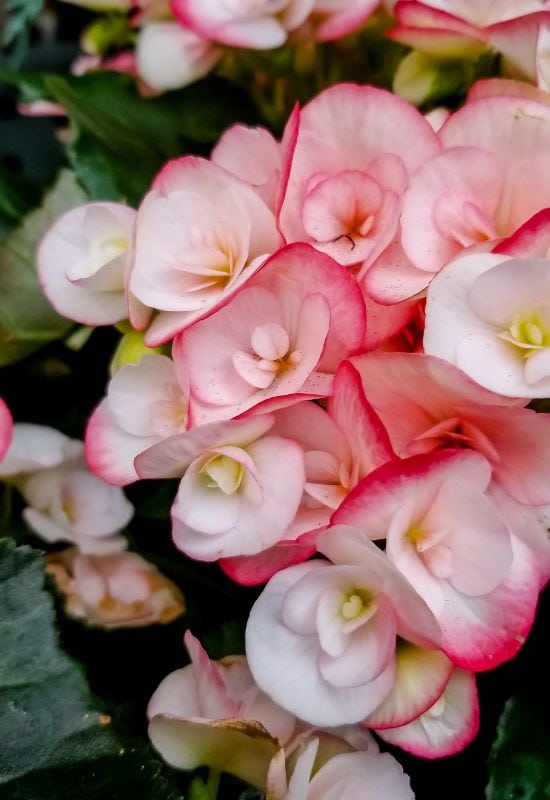
Tuberous begonias can regale your flower beds, borders and containers with huge floral displays throughout most of the season, from late spring to the end of fall! Coming from underground tubers, they have a range of flower shapes and colors like few other bulbous perennials!
From single varieties with butterfly wing like nodding blossoms to large . Smooth or ruffled varieties that reach 9 inches across (22 cm)! The palette is warm and bright, with yellows, pinks, oranges, and of course candid white!
But begonias also have some of the most decorative foliage you can find! Fleshy and eye catching, you can have glossy bright green, but also purple, and often variegated. The shapes of the is quite creative as well…
Pointed and dented, broad and serrated, heart shaped, or even roundish, they always give you dense and lush clumps to give your garden that florid look we all so much love.
Tuberous begonias are really not cold hardy, and this comes with their warm climate origin. In order to be safe and tale no risks, you should plant them in late spring to a shallow depth of about 2 to 3 inches (5.0 to 7.5 cm).
You can jump start them in containers indoors, if you wish, in which case you can do it 8 to 10 weeks before the last frost. You will also need to uproot them and shelter them over winter.
Lots of Color and Flowers from Bulbs for Your Garden in Fall!
Not all bulbs blossom in spring then! While tulips and daffodils, maybe the most popular bulbous perennials of all, like to rush into blooms as soon as the soil warms up,
many other varieties like to wait, and give us lovely blossoms and bright colors all the way till it becomes cold again, in fall, when we very often need them most in our gardens!

Written By
Amber Noyes
Amber Noyes was born and raised in a suburban California town, San Mateo. She holds a master’s degree in horticulture from the University of California as well as a BS in Biology from the University of San Francisco. With experience working on an organic farm, water conservation research, farmers’ markets, and plant nursery, she understands what makes plants thrive and how we can better understand the connection between microclimate and plant health. When she’s not on the land, Amber loves informing people of new ideas/things related to gardening, especially organic gardening, houseplants, and growing plants in a small space.
